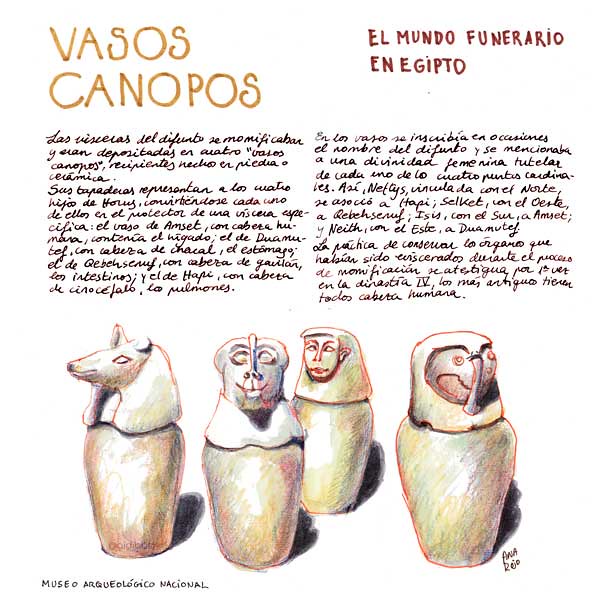Antiguo Egipto:
¿Qué hacer con la casquería mortuoria?
Embalsamarla, perfumarla y guardarla en frascos junto al propietario.

Vaso canope es el recipiente empleado en el Antiguo Egipto donde se depositaban las vísceras de los difuntos, lavadas y embalsamadas, para mantener a salvo la imagen unitaria del cuerpo.Había cuatro tipos de vasos canopos, que representaban a unas divinidades llamadas Hijos de Horus, quienes protegían su contenido de la destrucción. Las divinidades representadas eran:
________________________________________________
Funerary rites in Egypt
The deceased's internal organs were mummified and placed in four "canopic jars", containers made of stone or clay. Their lids depict the four Sons or Horus, each of whom protects a specific organ: the jar of human-headed Imsety contained the liver; that of jackal-headed Duamutef, the stomach; than of halcon-headed Qebhsunuef, the intestines; and that of baboon-headed Hapy, the lungs. The jars were sometimes inscribed with the deceased's name and a reference to one of the female deities that represented the four cardinal points. Nephthlys, goddess of the North, was associated with Hapy, Selket, goddess of the West, with Qebhsenuef; Isis, goddess of the South, with Imsety; and Neith, goddess of the East with Duamutef.
The custom of preserving the organs eviscerated during the mummification process was first recorded in the Fourth Dynasty. All the oldest jars have human heads. The custom of depicting the four Sons of Horus on the lids became widespread towards the end of 18th Dynasty and continued until the Roman period.
¿Qué hacer con la casquería mortuoria?
Embalsamarla, perfumarla y guardarla en frascos junto al propietario.

Vaso canope es el recipiente empleado en el Antiguo Egipto donde se depositaban las vísceras de los difuntos, lavadas y embalsamadas, para mantener a salvo la imagen unitaria del cuerpo.Había cuatro tipos de vasos canopos, que representaban a unas divinidades llamadas Hijos de Horus, quienes protegían su contenido de la destrucción. Las divinidades representadas eran:
- Amset: vasija con tapa en forma de cabeza humana, donde se guardaba el hígado.
- Hapy: vasija con tapa en forma de cabeza de papión (babuino), donde se depositaban los pulmones.
- Kebeshenuef: vasija con tapa en forma de cabeza de halcón, que contenía los intestinos.
- Duamutef: vasija con tapa en forma de chacal, con el estómago del difunto.
________________________________________________
Funerary rites in Egypt
The deceased's internal organs were mummified and placed in four "canopic jars", containers made of stone or clay. Their lids depict the four Sons or Horus, each of whom protects a specific organ: the jar of human-headed Imsety contained the liver; that of jackal-headed Duamutef, the stomach; than of halcon-headed Qebhsunuef, the intestines; and that of baboon-headed Hapy, the lungs. The jars were sometimes inscribed with the deceased's name and a reference to one of the female deities that represented the four cardinal points. Nephthlys, goddess of the North, was associated with Hapy, Selket, goddess of the West, with Qebhsenuef; Isis, goddess of the South, with Imsety; and Neith, goddess of the East with Duamutef.
The custom of preserving the organs eviscerated during the mummification process was first recorded in the Fourth Dynasty. All the oldest jars have human heads. The custom of depicting the four Sons of Horus on the lids became widespread towards the end of 18th Dynasty and continued until the Roman period.

Comentarios
Publicar un comentario